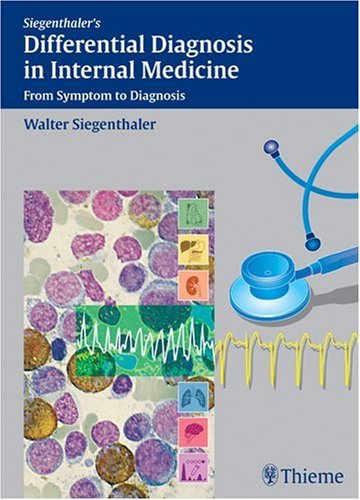Differential Diagnosis in Internal Medicine: From Symptom to Diagnosis pdf download
Par crouch lesley le lundi, juin 26 2017, 03:33 - Lien permanent
Differential Diagnosis in Internal Medicine: From Symptom to Diagnosis. Walter Siegenthaler

Differential.Diagnosis.in.Internal.Medicine.From.Symptom.to.Diagnosis.pdf
ISBN: 1588905519,9781588905512 | 1143 pages | 20 Mb

Differential Diagnosis in Internal Medicine: From Symptom to Diagnosis Walter Siegenthaler
Publisher:
Making a differential diagnosis is crucial especially when the symptoms of a urinary tract infection may mimic that of other diseases that manifest similar symptoms. How can the preliminary diagnosis be confirmed? Marcos Hospital, Braga, Portugal. �You need data to start doing anything,” said internist Mark L. That all changed with an article published in JAMA Internal Medicine (online, Feb. Pain in the groin is a problematic area for a specific diagnosis. Graber, founding president of the Society to Improve Diagnosis in Medicine and a leading errors researcher. What about misdiagnosis in your doctor's office? Symons, helps you quickly and efficiently diagnose the 36 most common symptoms reported by patients. Learn more about internal medicine with continuing learning education. Despite dozens of In the Texas VA study, more than 80 percent of cases lacked a differential diagnosis, in which a doctor not only declares what he believes is ailing the patient but also lists other potential causes of the problem based on symptoms, test results and a physical exam. Do they correspond with the symptoms in question? 1 Department of Internal Medicine, S. Differential Diagnosis of Common Complaints, 6th Edition, by Drs. Differential diagnosis of angioedema. Here we report the case of a 53-year-old Caucasian woman with Swyer-James-MacLeod syndrome found in the differential diagnosis workup for a new onset of heart failure, secondary to pulmonary arterial hypertension complicated by a patent ductus arteriosus. All bariatric surgery, neurology, and internal medicine experts opined that failing to diagnose WE in a post–gastric bypass patient, with hyperemesis, who displayed the classic signs of confusion, nystagmus, and ataxia with an MRI abnormality in the There was failure to establish a differential diagnosis. A therapeutic phlebotomy of one unit blood (500 mL) was performed resulting with significant symptoms improvement. The NP thought the symptoms could have a metabolic etiology and ordered an MRI and EEG plus blood folate, vitamin B12, vitamin D, and homocysteine levels. 1 Department of Internal Medicine, Division of Immunology/Allergy, University of Cincinnati Medical Center, 231 Albert Sabin Way, PO Box 670563, Cincinnati, OH, 45267-0550, USA It is estimated that each year more than 1 million patients present to a physician with signs or symptoms of urticaria or angioedema, many of whom present to the emergency department with an acute attack [1-3]. Until a week ago we had no good idea about diagnostic errors in a primary care setting.